CPS Students Discover Campus...and That Learning Can Be Fun
August 22, 2012
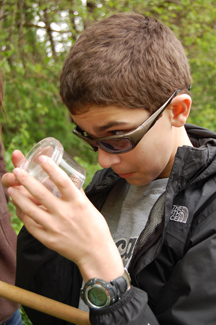
CPS student examines an insect at the Pollinatarium.
Some smoke. A little loud noise. A physics gizmo that makes one's hair stand on end. Mutilating a Pepsi can with the force of air. Tramping around hunting insects in the great outdoors armed with a butterfly net. Illinois scientists pulled out all the stops to show a group of Chicago students that exploring science at a world-class university can be fun!
On Friday, April 13, ten schools from the Chicago Public Schools (CPS) district toured the Illinois campus. Jointly orchestrated by the I-STEM Education Initiative and the CPS Office of Pathways to College and Career, this event exposed students from five Chicago middle schools and five high schools to a sampling of the many exciting opportunities available in science at the University of Illinois at Urbana-Champaign. On campus to participate in the 2012 Illinois Science Olympiad State Tournament, these Chicago students were exposed to a variety of scientific disciplines and units, including Chemistry, Physics, several Engineering departments, BioMathematics, Veterinary Medicine, and ACES.
Students began their tour by seeing the eDream movie produced by the Illinois eDream (Emerging Digital Research and Education in Arts Media) Institute, which promotes arts conceived, created, and conveyed through digital technologies. After lunch, the group split up, with the middle school students touring the south end of the campus and the high school students touring the north.

Student uses net to catch insects at the Pollinatarium.
The middle school students toured Veterinary Medicine’s Basic Sciences Building and Teaching Hospital, where students were given the opportunity to explore some of the hands-on instructional devices veterinary medicine students learn on. While some students toured the Lincoln Avenue farm facility, others visited Entomology’s Pollinatarium. Armed with nets, students roamed about the grounds capturing insects, and also learned about bee anatomy by constructing models with beads and yarn. The south tour culminated with a visit to the ACES library.
High school students attended presentations and toured several units on the north end of campus. In a presentation that lived up to the “High-Energy Chemistry” slogan emblazoned on their lab coats, instructor Gretchen Adams and Don DeCoste’s fun, three-ring circus used loud noises, smoke, and chemistry slight of hand to grab the students’ attention. Then, while the students' mouths were open in surprise or laughter, they inserted a few nuggets.
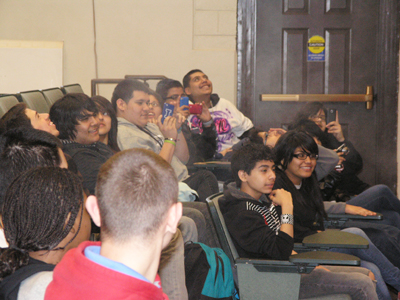 Chicago students enjoy Gretchen Adams' shenanigans during chemistry presentation.
Chicago students enjoy Gretchen Adams' shenanigans during chemistry presentation.For example, students were asked to make observations about a lighted candle placed under a beaker, which eventually sputtered and went out. After discovering that they had been duped—the "candle" Adams bit into was actually a carved cucumber, and the “windex” she took a swig of after cleaning the outside of the beaker was actually water with blue food coloring in a Windex bottle—students fully understood that along with carefully observing, another essential part of the scientific method involves using care when drawing conclusions. The “meat” of the presentation also included a little recruiting: incentives such as hirability based upon an excellent education and Illinois' reputation, but also expectations the Chemistry department has of its students, and how students can best take advantage of the opportunity to study Chemistry at Illinois.
Also proving that physics can be fun, professor Kevin Pitts had the high schoolers on the edge of their seats with an entertaining presentation where volunteers from the audience helped demonstrate physics principles about motion and electricity. For example, one student volunteer was seated on a platform designed to spin. Pitts handed the volunteer a spinning gyroscope; when the student flipped it, he began to spin the opposite direction, helping to demonstrate the conservation of angular momentum principle. Pitts also recruited a couple of volunteers to help demonstrate some principles about electricity. Using a plasma ball, he illustrated that even the students themselves could conduct electricity if they were not grounded. One electrifying feat involved using a Van de Graaff generator (named after a guy named Van de Graaf, Pitts supplied) that provided electrons which built up and caused the student's hair to stand on end.
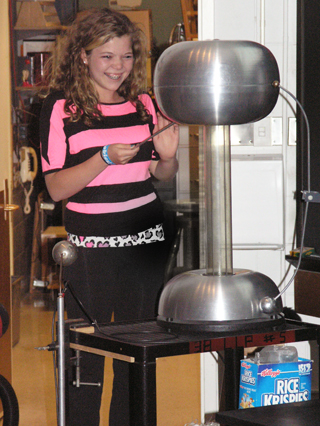 |
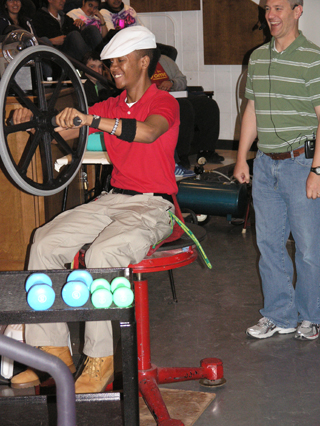 |
|---|---|
| Student experiences electrifying effect of Van de Graaff generator. |
Chicago student helps Professor Pitts demonstrate the conservation of angular momentum. |
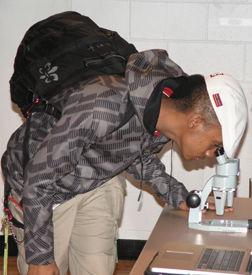 Student uses microscope to examine algae at BioMath poster presentation.
Student uses microscope to examine algae at BioMath poster presentation.
In the final presentation of the day, BioMath students from Michael Dietze’s Ecological Forecasting Laboratory presented a poster session to the students about the cross-disciplinary work they are doing linking mathematics and biology to find ecological solutions. The session was the culminating project for a joint course in both mathematics and biology, Research Seminar in Mathematical Biology, for which students were to present their research project results at a level these talented high school students could understand.
Author/Photographer: Elizabeth Innes, Communications Specialist, I-STEM Education Initiative
More: 6-8 Outreach, 8-12 Outreach, CPS, I-STEM Initiatives, 2012













.jpg)
















